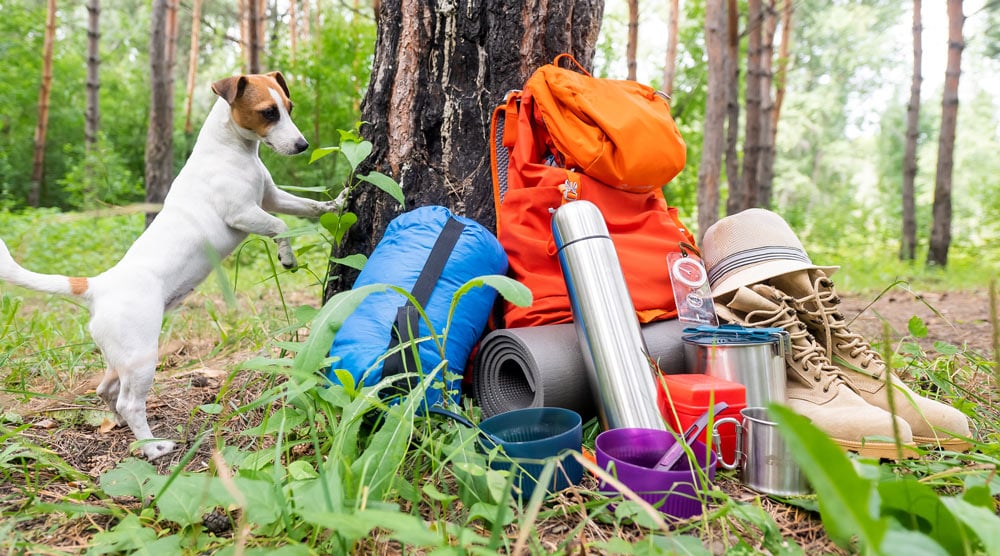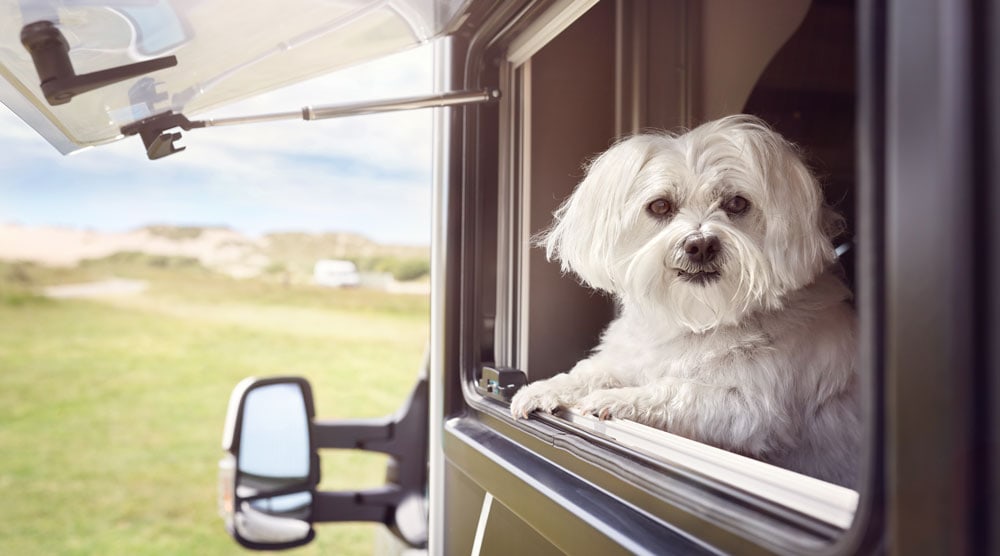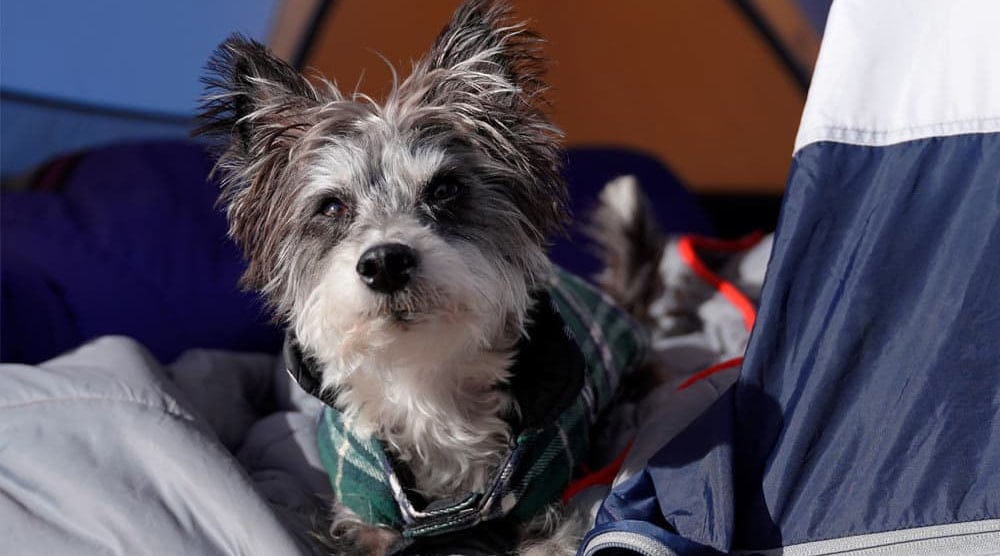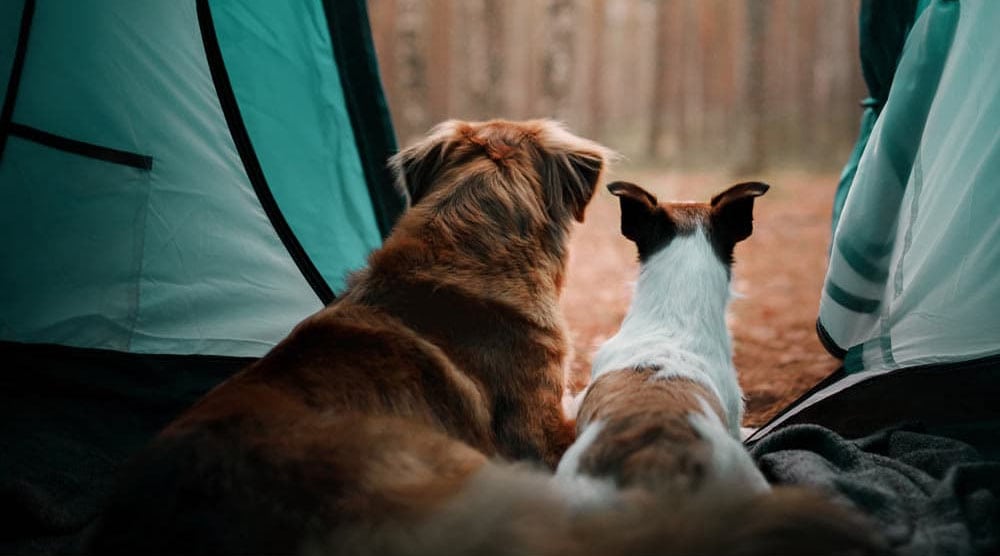Camping with your dog can be a fantastic adventure. But there’s nothing worse than arriving at your destination, only to realise you’ve forgotten an important piece of kit. We’ve got your dog covered with our helpful dog camping gear checklist.
Contents
- 15 Essential Items and Gear When Camping With Your Dog
- 1. Water & Water Bowls
- 2. Food & Dog Bowl (and Treats!)
- 3. Comfortable Dog Bed That’s Suitable for Camping
- 4. Poop Bags
- 5. Dog Boots
- 6. Dog First Aid Kit
- 7. Regular Leash and a Long Line
- 8. Dog Collar With ID Tag
- 9. Comb, Brush and Tick Remover
- 10. Toys and Long-Lasting Chews
- 11. LED Collar or Collar Light
- 12. Paw Balm
- 13. Towels (Especially in Wet Conditions)
- 14. Jumper and Coat
- 15. Health Records
- Summary
You’ll need to check the destination is suitable for a dog, that the weather isn’t going to scupper things and, most importantly, that you’ve packed the right supplies.
To help you have a successful trip, we’ve developed this dog camping gear checklist. Hopefully it helps you feel more organized when your own packing list is already as long as your arm!
15 Essential Items and Gear When Camping With Your Dog
1. Water & Water Bowls
Okay, this may seem obvious gear to start the list, but making sure you have enough water for your dog when you’re camping is vital. This is easy if you’re staying on a camp site with drinking water, but more difficult if you’re taking a more adventurous approach, as the weight of water quickly becomes too much to carry.
If you’re wild camping, you’ll need to consider where the nearest water source is and whether you need to bring a water filtration system. Many natural water sources can be dangerous to dogs, so filtration is nearly always required. Even some designated camping spots don’t have fresh drinking water, so it’s best not to assume without checking.
Don’t rely on your dog drinking from nearby streams or ponds. You may find there aren’t enough natural drinking sources, and you certainly don’t want your dog to become dehydrated. In hot weather, a lack of water also greatly increases the chances of heat exhaustion.
Water can also harbour bacteria and toxins that can make your dog feel ill, and, in some cases, be deadly.
In hot weather conditions, it isn’t uncommon for toxic blue-green algae to develop in still water or slow-flowing streams and rivers. If your dog was to drink from this source, it could be fatal – especially if you’re far from veterinary care.
If you’re doing a multi-day trek and can’t carry enough water for you both, plan freshwater topping-up stops in advance.
Don’t forget to bring a drinking receptacle for your dog when camping. There are collapsible dog bowls designed just for this purpose.
2. Food & Dog Bowl (and Treats!)
Packing enough dog food for a full camping trip can seem overwhelming, especially for large breeds on multi-day adventures.
It’s vital that your dog has his normal food though. Suddenly changing diet could cause an upset tummy, which is distressing for your dog and could cause dehydration. It’s also not pleasant if your pet has an accident in the tent!
If you’re struggling to accommodate all the extra food, maybe you could arrange to have food and other supplies transported to designated resupply points along the way.
Don’t forget that your pet may need additional food if you’re doing more hiking or activities than normal. The increased exercise will result in them burning off more calories. Camping and hiking in cold weather conditions can also burn off more energy.
Additionally, try to plan your dog’s meal times so they won’t be hiking on a full tummy.
Feeding smaller, more frequent meals, keeping your dog well-hydrated, and allowing them at least an hour to digest before setting off can help to reduce the risk of gastric torsion (commonly referred to as bloat). This can be a quick developing, and life-threatening condition. Larger breeds and those with deep chests are more at risk of developing bloat.
If, like me, you’re always working on training and rewarding your dog for good behavior, don’t forget a supply of treats when camping or hiking. They will be handy for encouraging a good recall in a new environment, for distraction and confidence-building in new situations, and for keeping the bond between you both strong.
3. Comfortable Dog Bed That’s Suitable for Camping
Your dog’s warmth and comfort in the tent should be a top priority. Even if you have a hardy dog, expecting them to sleep on a hard groundsheet when camping isn’t fair.
You want to make sure they have bedding that will support their joints, especially after a hard day on the trails. Their bedding should also insulate and elevate them from the cold ground.
There are a wide variety of dog beds for camping trips. Some can be compressed or rolled up into a small size for travelling. There are even specially designed doggy sleeping bags. Just make sure that what you bring will provide enough warmth and insulation. Even in the summer, the temperatures can drop drastically through the night. You should also check the weight of a dog bed before you buy.
My dog has her own self-inflating Therm-a-rest mattress and an all-weather sleeping bag. Both are super light and compress to fit into my rucksack. They also provide good comfort, elevation from the cold ground and the sleeping bag is very insulated. If she gets too warm, I just open the sleeping bag, and she can sleep on top instead of inside it.
I also used the inflatable mattress when I camped with my senior dog, and it was comfortable for her old, arthritic joints.
4. Poop Bags
Don’t forget poop bags when camping or hiking! Respecting the campsite you’re staying in should be a priority.
If you’re hiking in a remote landscape, it can be tempting just to leave your dog’s poop, but, to be a truly responsible hiker, you should follow the “Leave No Trace” principles. There’s even a chance that your dog’s poop could carry germs or bacteria that could be a threat to the local wildlife or contaminate nearby waterways.
If you don’t want to pack out the waste, generally Leave No Trace rules are the same as they are for human waste. The poop should be buried in a hole that is at least 6 – 8 inches deep and a minimum of 200 feet away from any freshwater sources.
If you’re not keen on carrying a smelly poop bag around for the rest of your hike, you could consider getting a portable waste bag holder that contains the bag and the smells!
5. Dog Boots
If you know you’re going to be covering a lot of rough terrain, your pet may benefit from wearing boots. These are particularly useful if there are sharp rocks or other surfaces that could damage paw pads.
Boots can also protect against hot tarmac. If the road surface is uncomfortable for you to touch with bare skin, then it will be just as risky for your dog’s pads too. While you shouldn’t hike with your dog in very hot weather, the boots can help protect their pads from becoming burnt or blistered.
Similarly, if you’re hiking in snowy and icy conditions, boots can stop the pads from cracking and will help to prevent ice balls from gathering.
Wearing boots isn’t natural for your dog, so it’s important to get them used to wearing them in advance of the trip. Pair any try-on sessions with lots of yummy treats, so they associate the boots with good things.
You also want to make sure that they’re a good fit. The boots shouldn’t be so tight that they rub, but if they aren’t tight enough, they will come off too easily.
Ruffwear Grip Trex boots are well-recommended and often used by search and rescue dogs. They’re expensive though and, if your dog loses one in deep snow, it can be frustrating. Pawz disposable boots are a good option for emergencies and, if one gets lost, it isn’t such a big deal.
6. Dog First Aid Kit
Regardless of how organized and sensible you are on your camping adventures, accidents can happen. Being prepared and carrying a well-stocked doggy first aid kit can be helpful. A first aid kit could even be lifesaving when you don’t have immediate access to a vet.
Some of the key items to carry include:
- A tick twister/remover. You should also make sure your dog is fully up to date with their antiparasitic treatments before the trip.
- A soft muzzle. This can be helpful if you need to move an injured, stressed and in pain dog, as pain can make a dog more likely to bite. It’s a good idea to do some advanced positive reinforcement muzzle training with your dog, so they’re relaxed and accepting of wearing one.
- Gauze and bandages
- An emergency blanket
- Self-adhesive tape and scissors
- Hydrogen peroxide, or another suitable antiseptic
- Antibiotic wipes or spray
- A torch
- Any medication your dog uses
Related Article: 13 Tips for Safely RVing With Your Dog
7. Regular Leash and a Long Line
A leash is essential – even if you usually walk your dog off leash at home.
Some National Parks and other designated areas only allow dogs if they’re kept on the leash. If you’re in an area with a lot of wildlife or livestock, you should always keep your dog on the leash.
If you want to have your hands free, consider a leash that attaches around the waist, or attach your leash to a dog walking belt. I sometimes use the Ruffwear Roamer Leash if I need to do a bit of scrambling while my dog is on the leash.
Many campsites, understandably, don’t allow dogs unless they’re on the leash or tethered while at the tent. You may want to use a tie-out stake beside the tent, so your dog can move around without breaking any rules.
You shouldn’t leave your dog tied up unattended when camping though. They could easily get stolen or distressed. Heat stroke is also a real danger in hot weather.
I always take a long line on multi-day camping trips. This is a soft, extra long, slightly thinner leash without a handle that is useful for giving my dog more freedom in spaces she can’t be let off. It only works in open spaces as it can easily become tangled around trees or other obstacles, and you need to be mindful of other people and dogs (you don’t want to trip anyone up!)
If you’re using a long line for your pet, make sure it’s always attached to a harness. Your dog can build up a fair bit of speed before it reaches its maximum length, which could cause a neck injury when attached to a collar.
8. Dog Collar With ID Tag
Making sure your dog has an up to date microchip and ID Tag is always essential, but it’s even more important when traveling in an unfamiliar environment. If your dog is off-leash and they run off, they’re more likely to get disoriented and lost.
If you’re staying in a local campsite, you could even use a temporary tag with the site’s details. This is especially useful if you’re in an area with a patchy phone signal.
I always carry a backup ID tag, just in case the original one comes loose and goes missing.
If there’s a suitable signal in the area you’re visiting, you could consider using a smart dog collar for extra peace of mind. These use GPS to track where your dog is – although they aren’t always 100% accurate.
9. Comb, Brush and Tick Remover
I never go on a camping trip without my dog’s comb and brush. Her coat gathers burrs, sticks and other debris, which are uncomfortable and result in tight mats if not removed. Combing these out around the campfire at night is a frequent ritual that keeps her coat in top condition.
It’s also a good idea to carry a tick twister and inspect your dog each night. Even if you use a good quality antiparasitic treatment, your dog can still get a few ticks on a trip, especially if you’re hiking in forested trails or areas with a lot of shrubs and undergrowth.
10. Toys and Long-Lasting Chews
At the end of a hard day on the trail, you often won’t leave the campsite again until the following morning. This means there can be a lot of down-time.
Hopefully, your dog will be happy just to chill and relax. After all, they will have had a hard day too!
If you have a high-energy dog, they may still get restless. Bringing along an interactive toy or some edible chews can keep them stimulated and entertained.
Some dogs also find familiar toys reassuring and comforting when in a new environment, so you may want to bring along their favourite soft toy.
Puzzle feeders are also worth bringing (if you have space!) These types of interactive feeders are ideal for additional enrichment or to slow down your dog if they gulp their food
11. LED Collar or Collar Light
If you need to take your dog out of the tent for a potty break during the night, or for a last stroll after the sun goes down, popping on an LED collar or a light that attaches to their collar can help you keep track of them more easily. It can also make your dog more visible for others if you’re walking nearby traffic or other campsite users.
12. Paw Balm
After a long day on rough trails, applying a paw balm can moisturize and soothe your dog’s pads. It also creates a barrier to prevent cracking and protect against cold weather conditions.
13. Towels (Especially in Wet Conditions)
Making sure your dog is as dry as possible before nighttime is essential, especially when the weather is cold. If your dog is soaked, it’s much harder for them to retain body heat.
Bring plenty of towels to thoroughly dry your dog before they get in the tent. If they make their bedding wet, it will be difficult to dry out, and your dog might struggle to get cozy.
Microfibre towels fold down into a compact space and they also dry off much faster than a traditional towel.
14. Jumper and Coat
The best way to ensure your pet is dry is to avoid their fur getting wet in the first place. So, if the weather forecast is poor, you may want to consider a practical and well-fitting dog coat.
If your pet is susceptible to the cold, you may also want to bring a dog jumper to keep them extra cozy through the night. You certainly don’t want to put a wet jacket back on them and, even if their coat is dry, it will likely be too bulky and uncomfortable for use overnight.
I’m a huge fan of the Equafleece jumpers and suits. They’re comfortable, well-fitting, snug, and even water-repellant for use outside on a damp day.
15. Health Records
While you’ll hopefully have an enjoyable and safe camping trip, it’s always a good idea to be prepared. If your dog gets injured or develops any other problem that might require veterinary attention, knowing the locations and details of nearby vets gives you one less thing to worry about.
Make sure you also carry your dog’s health records. These can be helpful for an unfamiliar vet, especially if your dog has any medical conditions.
Summary
Camping with your dog can be a fun way to bond with your pet. Your dog also gets to join in with more adventures – and you don’t need to fork out for a dog sitter!
A camping trip with your canine friend requires extra planning and lots more packing though. There are essentials, such as food, water supplies, medication and bedding, plus lots of items that can make the trip safer and more enjoyable.
Hopefully, this dog camping gear checklist will help you avoid forgetting something vital for your four-legged friend. Happy Camping!




